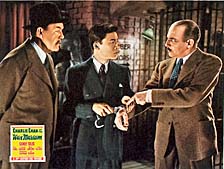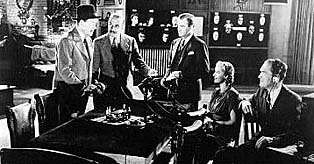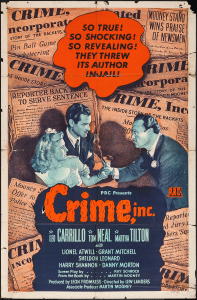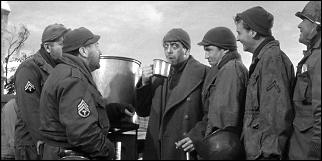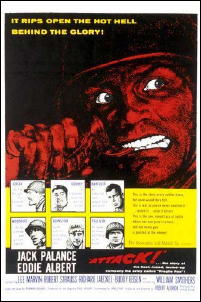Reviewed by DAVID VINEYARD:
H. BEDFORD-JONES writing as ALLAN HAWKWOOD – The Gate of Farewell. Originally serialized in Argosy January-February 1914, as by H. Bedford-Jones. Hardcover edition: Hurst and Blackett Ltd., UK, 1928.

Out east of Suez, in mysterious and sinister locales like Port Said and points East, West, North, and South, that’s where you will find the offices of John Solomon, Ships Stores, the canny deceptively gentle looking Cockney ship’s chandler who, with his greasy little red accounts book and stubby pencil, is a one man private secret service: “… if the Intelligence Department knew half as much about this part of the world as he does, the Foreign Office’d go crazy.â€
John Solomon is a mover and shaker, friend to native and kings, manipulator, schemer, adventurer, and the most dangerous man in dangerous waters, “… he has a finger in every pie from Jaffa to Zanzibar.†Underestimate the “… little plump man who wore a tarboosh jauntily cocked over one ear … and puffed a short clay pipe,†whose calm blue eyes “… spoke large of hidden secrets and unwritten lore …†at your own risk.
The Gates of Farewell is the first novel in the John Solomon series, which would include eleven novels serialized in the pulps for the most part and many short stories and extend into the 1930‘s, all penned in book form as by Allan Hawkwood from the prolific ‘King of the Pulps’ Canadian writer H. Bedford-Jones, whose output includes 50 novels and over 1400 novels, stories, serials, and articles published in virtually every major and some minor pulps, including Blue Book, Argosy, Adventure, Weird Tales … and across all boundaries of pulp fiction; adventure, sea stories (The Second Mate), historical (The Wilderness Trail, Nuala O’Malley, Firehair Skald of the Haradee …), lost worlds (The Temple of Ten with W. S. Robertson), swashbuckler (tales of d’Artagnan, Cyrano, Denis Burke, and various others), mystery (The Mardi Gras Mystery), Holmes pastiche (one of his was so good that for years it was considered a lost Conan Doyle story until Bedford-Jones ‘fessed up), horror, gentleman crook (the excellent Riley Dillon series), Western (Arizona Argonauts, The Mesa Trail, The Sheriff of Pecos, Bowie’s Gold etc.), and more. Bedford-Jones listed Alexandre Dumas as his chief influence and it shows in his wide output and rich knowledge of so many different eras and places.
This one sets the model for the later books and stories about John Solomon, where a good dependable professional man is drawn into mysteries involving Solomon in various ports of call and used by Solomon as a stalking horse until Solomon closes in at the end of the book on the problem at hand. You don’t write 1400 novels and stories without a respect for formula.
The Gates of Farewell opens in pre-WWI Liverpool where Allan Tredgar, a young American importer (or “grocer†as he calls himself), is in a dive with his friend Lt. Krogness R.N., to hire a none to reputable, but honest tough little fighting cock of a Scots captain, one Hugh Cairn, to command his yacht the Spendthrift and sail to Port Said in search of his brother Bob, who disappeared and supposedly died five years earlier in Aden. Recently a ring of Bob’s showed up and Tredgar, believes his brother might still be alive.
Complicating matters are the renegade American Colonel Lionel Parrish and his thug bodyguard Jerry Sloog who also want to hire Cairn to command their ship, and when Cairn turns them down Parrish threatens both Cairn and Tredgar by note to stay out of that part of the world. Cairn warns of Parrish, but Tredgar thinks it is all melodrama never having seen the man.
Further complicating matters they rescue pretty Mary Grey, daughter of a missionary trying to reach her father in Berbera, when her ship goes down at sea East of Malta. She and Allan are attracted to each other and against Cairn’s wishes she decides to stay on at least to Port Said.
It’s in Port Said that Tredgar is led by Cairn to the little store (“Solomon’s templeâ€) in the Arab quarter where Solomon keeps to himself “ Old friend of mine … gun runner and all that, but the best man to go to for what you want.â€
Solomon takes an instant liking to the young American and gives him an engraved silver ring to wear as a sort of passport should he need it (and it saves his life and plays a role . He also, aside from confirming Bob might be alive, confirms the fantastic stories Cairn has been telling of Parrish, a renegade soldier turned radical Moslem who is Mokkhadem of prefect of the Bab al Wida’s or El Woda, the gate of farewell of the title, named for one of the gates leading out of Mecca, a “.. strip of coast inside the Twelve Apostles across from Eritrea — so desolate not even a Bedouin lives there.â€
That is where he will find news of Bob, but it is also where the Senusiyeh, a radical secret society of Moslem extremist who are working to throw the Sultan of Turkey, the Padishah, and his rule out of Africa and Arabia, are building a fortress it is rumored, under the command of Parrish. Ironically the British are fighting to help the ‘Sick Man of Europe†the Turkish Sultan to hold on to Arabia, where from August of 1914 (this was serialized in January of that year) they would be desperate to drive the Turks out with the help of Allenby, Lawrence, and what is now the Saudi Royal family. It’s an irony Solomon himself would enjoy.
After a great storm nearly wrecks the Spendrift (beautifully described by Bedford-Jones at his best), Tredgar and the rest end up captured by Hadji Abu Talib, a cruel and arrogant sort and member of the Senusiyeh, and taken to El Woda where they find hundred of slaves building a massive heavily armed fortress under the direction of Talib, none other than Parrish. There Tredgard also learns what role he and his brother play as he finds out Bob had learned from a dying Englishman in the states of the lost Abyssinian treasure of the Queen of Sheba, Solomon’s fabulous gift to her, which Parrish covets for the Senusiyeh to finance the campaign to throw the Padishah off the Arabian continent. Captured, forced into slavery, tortured along with his brother for the location of the treasure, watching as Parrish plans to take Mary Grey as his own, it all seems hopeless.
But of course, that kindly spider John Solomon has been weaving his web, and the Tredgar brothers, Parrish, the brutish Sloog, and everyone else are only flies ensnared and waiting for the right time to strike, which this being adventure fiction is at the very moment when all is at its most desperate.
This is an old-fashioned adventure story, though you can see the plot elements would not be too out of place in the latest Clive Cussler or James Rollins thriller with a bit of updating. It is somehow reassuring that the same secret societies and mad fanatics were at work then as now — in fact and fiction. There are flaws of course. There is absolutely no real reason for Mary Grey in much of the book, and she is barely characterized, though her ‘consent’ to the marriage to Parrish is key to the big finale and Solomon’s plans, and the scenes with Tredgar are well enough written and not overly mushy.
And, there is some politically incorrect language, though not as much as you might expect. At worst it is the way people of the time actually spoke and thought, however disturbing to modern readers eyes and ears. Actually most of the Moslem characters, even some of the Senuisyeh, are portrayed as honorable and faithful, far from some of the extremes in popular fiction today, and Solomon is nowhere near as ruthless as most of today’s adventure heroes.
The pulp origins show some in structure and story, but in a positive light it is much more stylishly and straightforwardly written for all that. The book is very cinematic as well, in a positive sense and it isn’t hard to cast the main characters in your minds eye, Gary Cooper and Olivia de Haviland for Tredgar and Mary; Tully Marshall or J. Farrell MacDonald for the tough little Cairn; Henry Daniell or C. Henry Gordon for the renegade Parrish; Lon Chaney Jr. or Mike Mazurki as Sloog; and a Cockney accented Edmond Gwynne, Charles Winniger, or Cecil Kellaway for Solomon.
Considering, too, Bedford-Jones penchant for reproducing Solomon’s accent it is just as well he isn’t on stage for long in most of the books: “Paradise is werry nice no doubt; but I says as ’ow earth ’as its good points likewise.†A little of that goes a long way, but it is a small complaint about a splendid adventure series worthy to stand with Rider Haggard and Talbot Mundy, and dare I say it, John Buchan.


